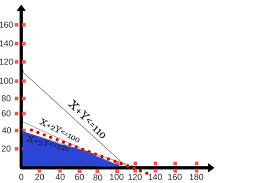
Linear programming
Linear programming
Order Instructions:
Just need to finish 4 simple question of linear programming of max/min problem.
you need to use excel (solver) in order to finish this.
ps i need to send you the question and some of the tut which similar to the assignment.
SAMPLE ANSWER
QUESTION 1
Let:
X1 = number of large aircrafts
X2 = number of medium aircrafts
X3 = number of small aircrafts
Max z: 8×1 + 5×2 + 2×3
Purchasing LP model: 8×1 + 5×2 + 2×3 120
Number of aircrafts serviced
Capacity of aircrafts in tone-miles
Fixed operating costs:
The Excel solver screenshot:
QUESTION 2
Max:
St.LP with optimal solutions
Value of objective function
QUESTION 3
Let x1 = Number of beds to produce
And x2 = Number of desks to produce
The LP model for the problem is:
Max z: 30x1 + 40x2
Subject to: 6x1 + 4x2 36
4x1 + 8x2 40
x1, x2 0
QUESTION 4
- Because values of zero (0) in the “Allowable Increase” or “Allowable Decrease” columns for the Changing Cells indicate that an alternate optimal solution exists.
Initial R.H.S. = 15
Increased R.H.S. = 20
Allowable Increase = 45
This mainly because increasing the RHS value would definitely lead to increased optimal function value within the feasible region on basis of the allowable increase value provided.
- 25.
Initial R.H.S. = 15
Decreased R.H.S. = 12
Allowable Decrease = 5
This mainly because decreasing the RHS value would definitely lead to decreased optimal function value within the feasible region on basis of the allowable decrease value provided.
Initial R.H.S. = 20
Increased R.H.S. = 32
Allowable Increase = 10
This mainly because increasing the RHS value would definitely lead to increased optimal function value within the feasible region on basis of the allowable increase value provided.
- This is due to the fact that there would be an reduction in resources utilization leading to increased productivity.
| x1 | const 1 | const 2 | ||||||||
| 0 | 8 | 5 | ||||||||
| 1 | 6 | 4 | ||||||||
| 2 | 4 | 3 | ||||||||
| 3 | 1 | 1 | ||||||||
References
Anderson D., Sweeney D., & Williams T (2007). An Introduction to Management Science. London: West Publisher.
Arsham H. (2007). An Artificial-Free Simplex Algorithm for General LP Models, Mathematical and Computer Modelling, 25(1), 107-123.
Arsham H. (2012). Foundation of Linear Programming: A Managerial Perspective from Solving System of Inequalities to Software Implementation, International Journal of Strategic Decision Sciences, 3(3), 40-60.
Chvatal, V. (2013). Linear Programming. New York, NY: W. H. Freeman and Company.
Lawrence J., Jr., & Pasternack, B. (2012). Applied Management Science: Modeling, Spreadsheet Analysis, and Communication for Decision Making. Hoboken, NJ: John Wiley and Sons.
Roos C., Terlaky, T. & Vial, J. (2009). Theory and Algorithms for Linear Optimization: An Interior Point Approach. Hoboken, NJ: John Wiley & Sons.
Shenoy G.V. (2010). Linear Programming: Methods and Applications. Hoboken, NJ: John Wiley & Sons.
We can write this or a similar paper for you! Simply fill the order form!




